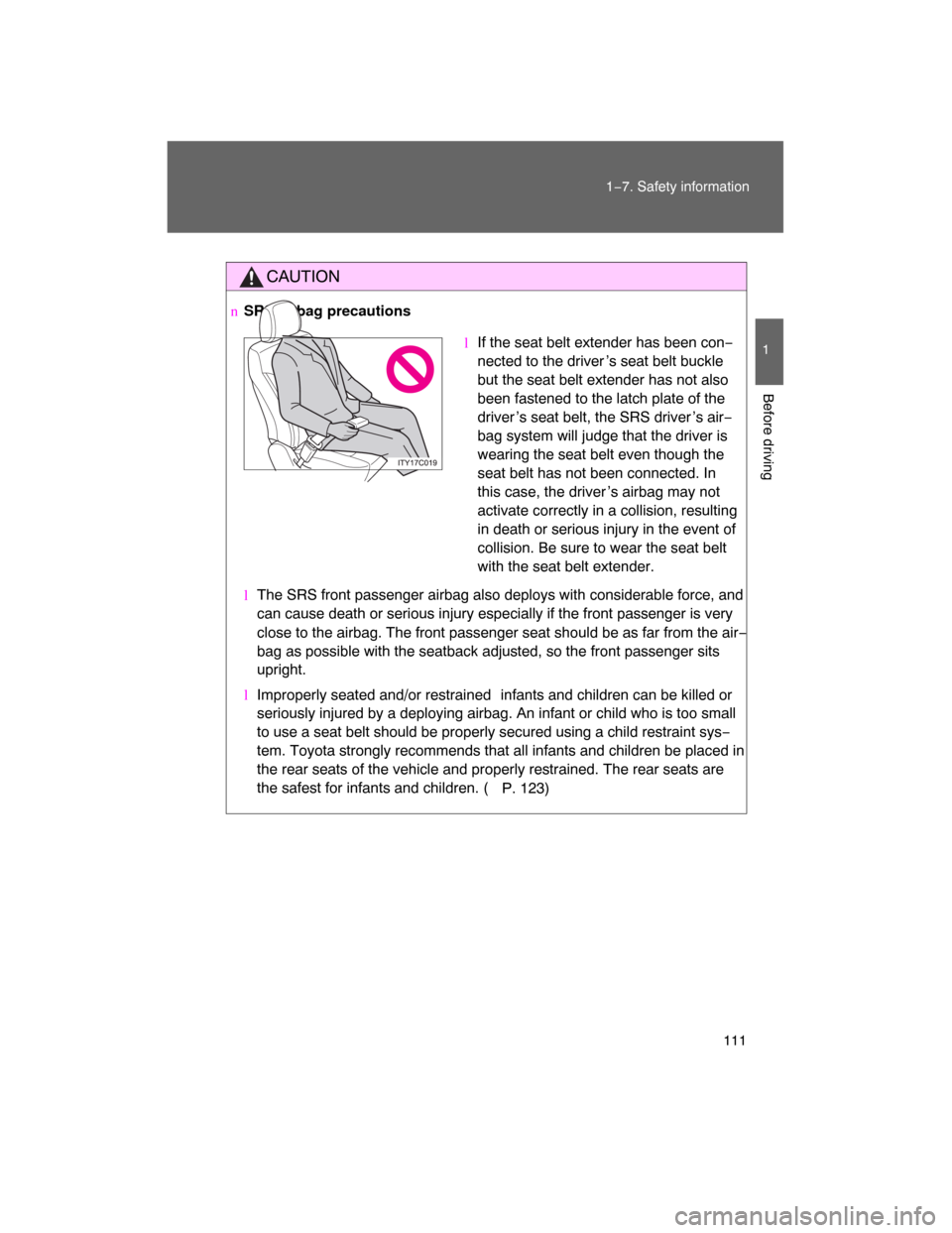Page 67 of 531
68 1−3. Adjustable components (seats, mirrors, steering wheel)
nInstalling the third outboard seat head restraints
Align the head restraint with the installation holes.
Push down the head restraint to the lock position.
nWhen not using the third center seat head restraint
CAUTION
nHead restraint precautions
Observe the following precautions regarding the head restraints. Failure to
do so may result in death or serious injury.
lUse the head restraints designed for each respective seat.
lAdjust the head restraints to the correct position at all times.
lAfter adjusting the head restraints, push down on them and make sure
they are locked in position.
l
Do not drive with the head restraints removed.
STEP1
STEP 2
Open the zipper on the back of the third
seat and stow the head restraint inside.
ITY13C043
Page 75 of 531

76 1−3. Adjustable components (seats, mirrors, steering wheel)
CAUTION
nUsing a seat belt extender
lDo not wear the seat belt extender, if you can fasten the seat belt without
the extender.
lDo not use the seat belt extender when installing a child restraint system,
because the belt will not securely hold the child restraint system, increas−
ing the risk of death or serious injury in the event of a collision.
lThe personalized extender may not be safe on another vehicle, when
used by another person, or at a different seating position other than the
one originally intended.
nPrecaution for pre�collision seat belts
Do not rely solely on the pre−collision system to avoid accidents. Always pay
attention to the surrounding conditions, and drive safely and responsibly.
NOTICE
nWhen using a seat belt extender
When releasing the seat belt, press on the buckle release button on the
extender, not on the seat belt.
This helps prevent damage to the vehicle interior and the extender itself.
Page 94 of 531
95
1−6. Theft deterrent system
1
Before driving
nCertifications for the engine immobilizer system
FCC ID: NI4TMIMB−1
NOTE:
This device complies with Part 15 of the FCC Rules. Operation is subject to
the following two conditions: (1) this device may not cause harmful interfer−
ence, and (2) this device must accept any interference received, including
interference that may cause undesired operation.
FCC WARNING:
Changes or modifications not expressly approved by the party responsible
for compliance could void the user ’s authority to operate the equipment.
Page 95 of 531
96 1−6. Theft deterrent system
CAUTION
nCertifications for the engine immobilizer system
Changes or modifications not expressly approved by the party responsible
for compliance could void the user ’s authority to operate the equipment.
NOTICE
nFor proper system operation
Do not modify, remove or disable the engine immobilizer system. If any
unauthorized changes or modifications are made, the proper operation of
the system cannot be guaranteed.
Page 109 of 531

110 1−7. Safety information
CAUTION
nSRS airbag precautions
Observe the following precautions regarding the airbags.
Failure to do so may cause death or serious injury.
lThe driver and all passengers in the vehicle must wear their seat belts
properly.
The SRS airbags are supplemental devices to be used with the seat belts.
lThe SRS driver airbag deploys with considerable force, and can cause
death or serious injury especially if the driver is very close to the airbag.
The National Highway Traffic Safety
Administration (“NHTSA”) advises:
Since the risk zone for driver airbag is the first 2 − 3 in. (50 − 75 mm) of
inflation, placing yourself 10 in. (250 mm) from your driver airbag provides
you with a clear margin of safety. This distance is measured from the cen−
ter of the steering wheel to your breastbone. If you sit less than 10 in. (250
mm) away now, you can change your driving position in several ways:
�Move your seat to the rear as far as you can while still reaching the
pedals comfortably.
�Slightly recline the back of the seat.
Although vehicle designs vary, many drivers can achieve the 10 in.
(250 mm) distance, even with the driver seat all the way forward, sim−
ply by reclining the back of the seat somewhat. If reclining the back of
your seat makes it hard to see the road, raise yourself by using a firm,
non−slippery cushion, or raise the seat if your vehicle has that feature.
�If your steering wheel is adjustable, tilt it downward. This points the air−
bag toward your chest instead of your head and neck.
The seat should be adjusted as recommended by NHTSA above, while still
maintaining control of the foot pedals, steering wheel, and your view of the
instrument panel controls.
Page 110 of 531

111
1−7. Safety information
1
Before driving
CAUTION
nSRS airbag precautions
lThe SRS front passenger airbag also deploys with considerable force, and
can cause death or serious injury especially if the front passenger is very
close to the airbag. The front passenger seat should be as far from the air−
bag as possible with the seatback adjusted, so the front passenger sits
upright.
lImproperly seated and/or restrained infants and children can be killed or
seriously injured by a deploying airbag. An infant or child who is too small
to use a seat belt should be properly secured using a child restraint sys−
tem. Toyota strongly recommends that all infants and children be placed in
the rear seats of the vehicle and properly restrained. The rear seats are
the safest for infants and children. (
P. 123)
lIf the seat belt extender has been con−
nected to the driver ’s seat belt buckle
but the seat belt extender has not also
been fastened to the latch plate of the
driver ’s seat belt, the SRS driver ’s air−
bag system will judge that the driver is
wearing the seat belt even though the
seat belt has not been connected. In
this case, the driver ’s airbag may not
activate correctly in a collision, resulting
in death or serious injury in the event of
collision. Be sure to wear the seat belt
with the seat belt extender.
Page 139 of 531

141
2−1. Driving procedures
2
When driving
nDriving in the rain
lDrive carefully when it is raining, because visibility will be reduced, the
windows may become fogged−up, and the road will be slippery.
lDrive carefully when it starts to rain, because the road surface will be
especially slippery.
lRefrain from high speeds when driving on an expressway in the rain,
because there may be a layer of water between the tires and the road
surface, preventing the steering and brakes from operating properly.
nBreaking in your new Toyota
To extend the life of the vehicle, the following precautions are recommended
to observe:
lFor the first 200 miles (300 km):
Avoid sudden stops.
lFor the first 500 miles (800 km):
Do not tow a trailer.
lFor the first 1000 miles (1600 km):
�Do not drive at extremely high speeds.
�Avoid sudden acceleration.
�Do not drive continuously in the low gears.
�Do not drive at a constant speed for extended periods.
nDrum�in�disc type parking brake system
Your vehicle has a drum−in−disc type parking brake system.
This type of brake system needs bedding−down of the brake shoes periodi−
cally or whenever the parking brake shoes and/or drums are replaced.
Have your Toyota dealer perform the bedding−down.
nOperating your vehicle in a foreign country
Comply with the relevant vehicle registration laws and confirm the availability
of the correct fuel. ( P. 496)
Page 140 of 531

142 2−1. Driving procedures
CAUTION
nWhen starting the vehicle
Always keep your foot on the brake pedal while stopped with the engine run−
ning. This prevents the vehicle from creeping.
nWhen driving the vehicle
lDo not drive if you are unfamiliar with the location of the brake and accel−
erator pedals to avoid depressing the wrong pedal.
�Accidentally depressing the accelerator pedal instead of the brake
pedal will result in sudden acceleration that may lead to an accident
that could result in death or serious injury.
�When backing up, you may twist your body around, leading to a diffi−
culty in operating the pedals. Make sure to operate the pedals properly.
�Make sure to keep a correct driving posture even when moving the
vehicle only slightly, allowing you to depress the brake and accelerator
pedals properly.
�Depress the brake pedal using your right foot. Depressing the brake
pedal using your left foot may delay response in an emergency, result−
ing in an accident.
lDo not drive the vehicle over or stop the vehicle near flammable materials.
The exhaust system and exhaust gases can be extremely hot. This may
cause a fire if there is any flammable material nearby.
lDo not let the vehicle roll backwards while the shift lever is in a driving
position, or roll forward while the shift lever is in “R”.
Doing so may cause the engine to stall and lead to poor steering perfor−
mance, resulting in an accident or damage to the vehicle.
l
If the smell of exhaust is noticed inside the vehicle, open the windows and
check that the back door is closed.
Large amounts of exhaust in the vehicle can cause driver drowsiness and
an accident, resulting in death or a serious health hazard. Have the cause
of the problem inspected immediately.